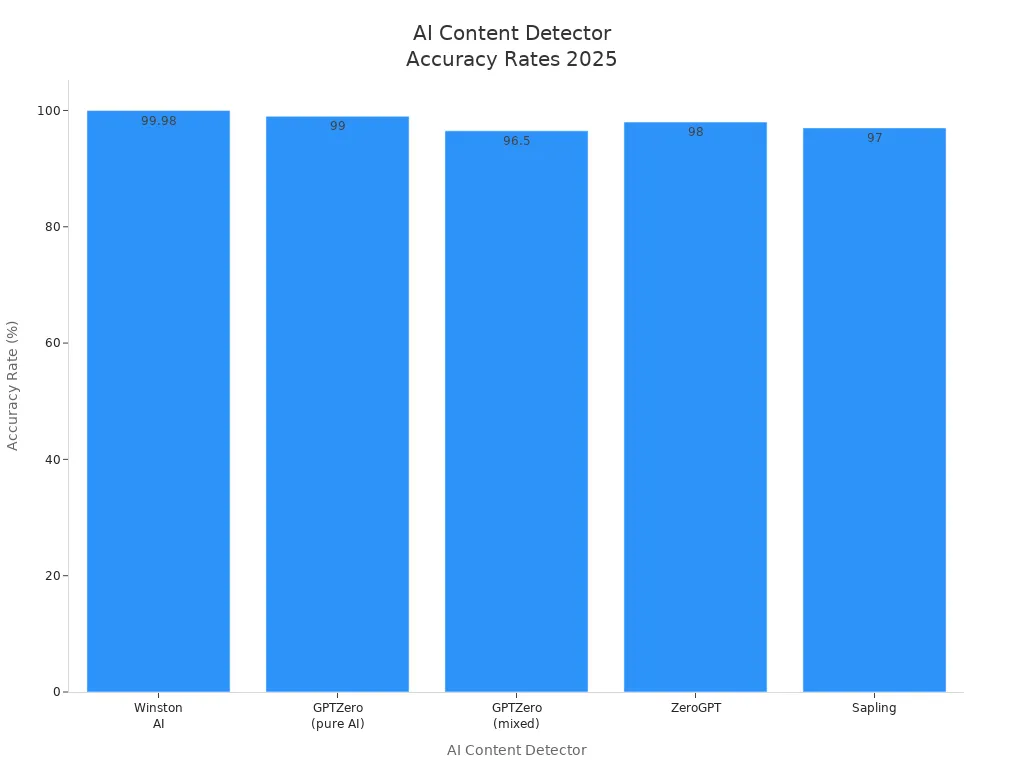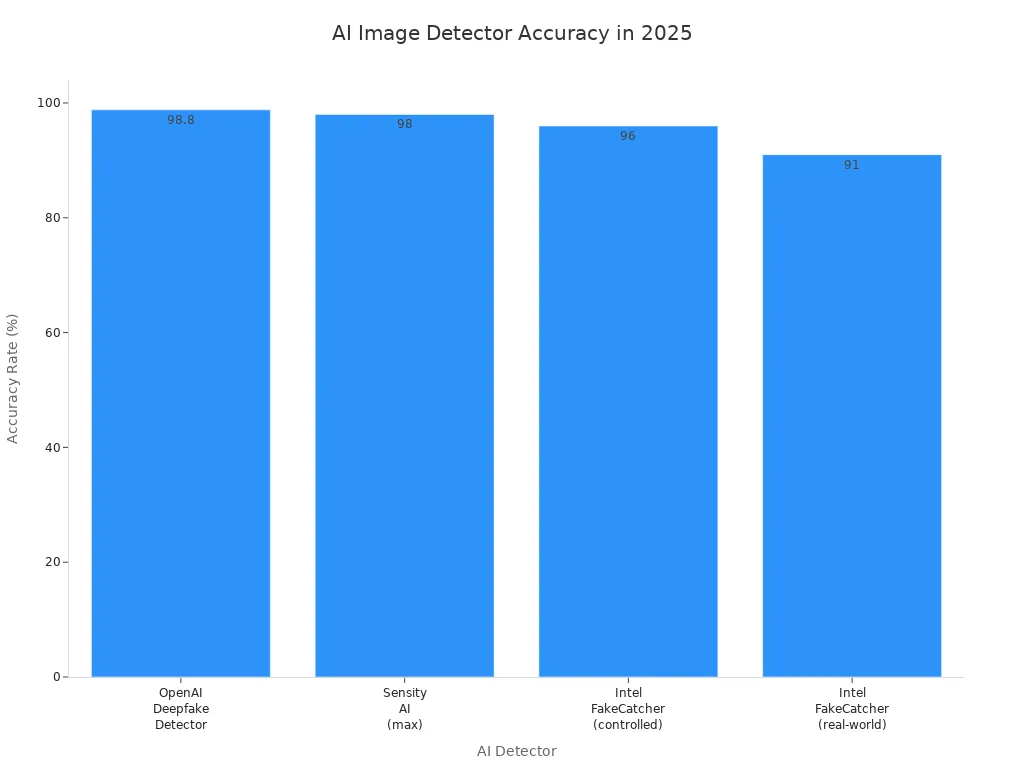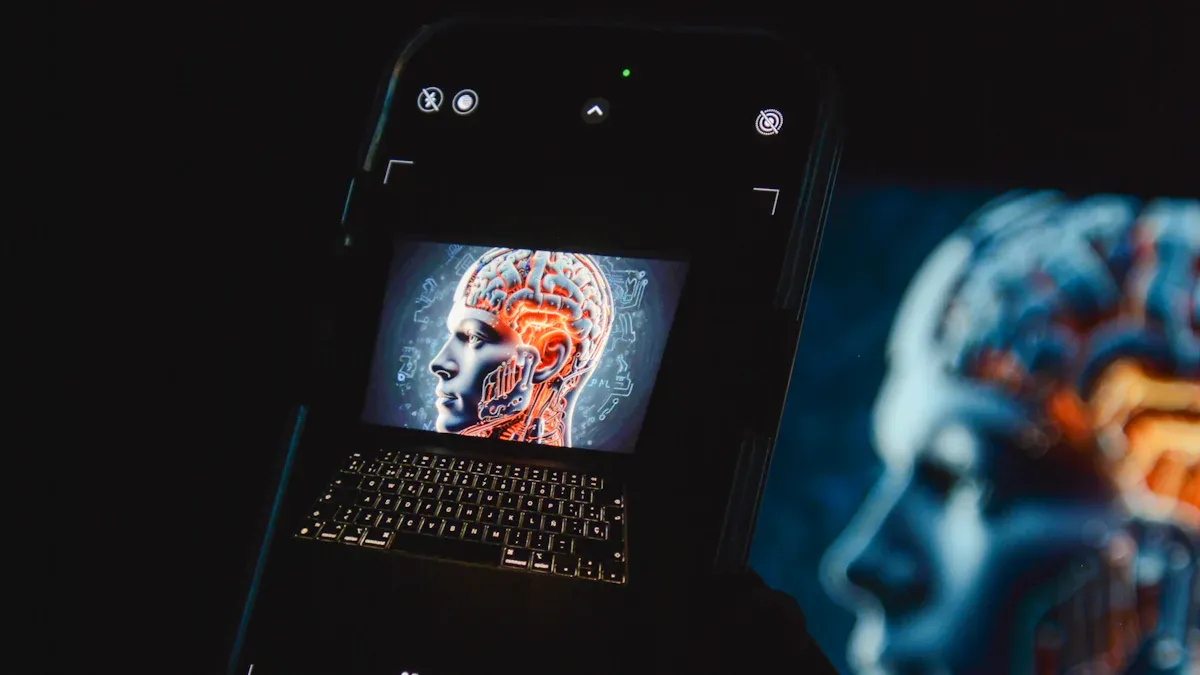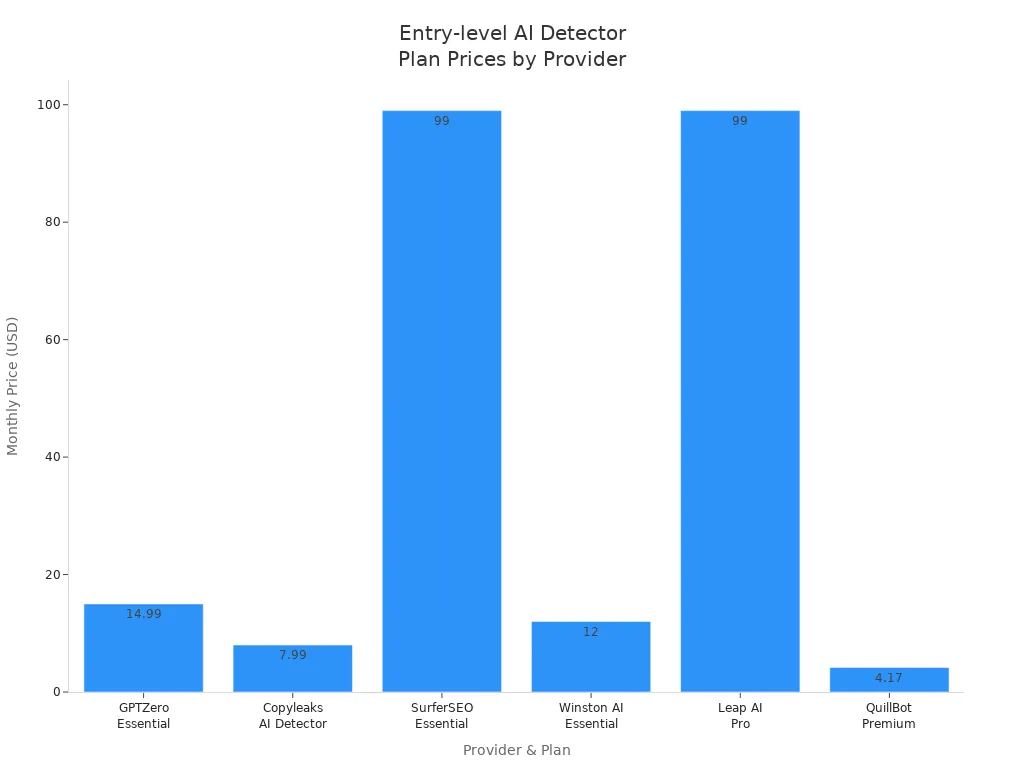
You probably notice more ai-generated content and images every day. The need for file ai detector tools keeps rising. Check out these stats:
|
Statistic Description |
Value / Percentage |
|---|---|
|
Generative ai adoption doubled between 2023 and 2024 |
|
|
Over 50% of marketing teams use ai to optimize content |
Yes |
|
Gen Z who have tried generative ai tools |
70% |
|
Customers concerned about data security |
75% |
ai content detectors now use machine learning and natural language processing. When you look for the best ai detectors, focus on accuracy, features, user experience, integration, and security. With so much ai everywhere, picking the best ai detectors and a good file ai detector helps you stay ahead.
Key Takeaways
-
AI file detectors help you spot AI-generated content in text and images, protecting your work and reputation.
-
Look for detectors with high accuracy, easy integration with your tools, and strong privacy to get reliable results.
-
Choose detectors based on your needs—free tools work for quick checks, while paid plans offer more features for large or professional projects.
Best AI Content Detectors
You want to find the best ai detectors for your needs, right? With so many ai content detectors out there, it can feel overwhelming. Let’s break down the top choices for 2025. These tools stand out for their accuracy, features, and user feedback. Whether you need a free ai detector for quick checks or an ai content detector for large documents, you’ll find a match here.
Tip: The best ai content detectors use advanced machine learning, frequent updates, and huge datasets to spot ai writing patterns—even in mixed or paraphrased text.

Quillbot
Quillbot (https://quillbot.com/ai-detector) is a familiar name for writers and students. You can use its ai content detector for extra writing analysis, especially if you want to check essays, homework, or resumes.
Best Use Case:
-
Quick checks for ai-generated content in academic papers, blog posts, and resumes.
Key Features:
-
Detects ai-generated content in English, Spanish, German, and French.
-
Works best with texts over 80 words.
-
Integrated with paraphrasing and plagiarism tools.
-
Highlights possible ai writing patterns.
Pros:
-
Easy to use and part of a larger writing platform.
-
Supports multiple languages.
-
Useful for educators and students.
Cons:
-
About 80% accuracy—can mislabel human writing.
-
Not recommended as your only ai content detector.
-
Needs longer text for best results.
ZeroGPT
ZeroGPT (https://www.zerogpt.com/) is one of the best ai detectors for fast, free ai detection. It claims over 98% accuracy and works well for basic ai content checks.
Best Use Case:
-
Free ai detector for quick, multilingual checks of blog posts, essays, and emails.
Key Features:
-
DeepAnalyse™ technology for detailed detection.
-
Supports many languages.
-
API access for teams and organizations.
Pros:
-
User-friendly interface.
-
Fast results and continuous updates.
Cons:
-
Struggles with advanced, humanized ai-generated content.
-
No proofreading or editing tools.
-
Not ideal for high-stakes or professional use.
Scribbr
Scribbr (https://www.scribbr.com/ai-detector/) helps students and educators check for ai-generated content in academic writing. It uses Turnitin’s technology for detection.
Best Use Case:
-
Academic paper checks for ai-generated content.
Key Features:
-
Integrates plagiarism and ai detection.
-
Highlights suspicious sections.
-
Simple interface.
Pros:
-
Good at spotting unedited ai-generated text.
-
Combines plagiarism and ai detection.
Cons:
-
Occasional false positives.
GPTZero
GPTZero (https://gptzero.me/) is a favorite among teachers and professionals. It’s one of the best ai content detectors for mixed or pure ai-generated content.
Best Use Case:
-
Detecting ai-generated essays, reports, and mixed-content documents.
Key Features:
-
Perplexity and burstiness scores to spot ai writing patterns.
-
Highlights ai-generated sections.
-
GPTZero Sources checks the credibility of cited sources.
-
API for integration.
Pros:
-
High accuracy (99% for pure ai, 96.5% for mixed).
-
Trusted by educators and publishers.
-
Unique source verification feature.
Cons:
-
Free version has limits.
-
May flag some human-written text as ai.
Grammarly
Grammarly (https://www.grammarly.com/ai-detection) is more than a grammar checker. Its ai content detector fits right into your writing workflow.
Best Use Case:
-
Seamless ai detection while editing in Word, Google Docs, or the Grammarly Editor.
Key Features:
-
AI Detection API for developers.
-
Confidence scores and section breakdowns.
-
Integrated with grammar and plagiarism checks.
-
Works in popular writing apps.
Pros:
-
User-friendly and familiar interface.
-
API for custom integrations.
Cons:
-
Detection is an estimate, not a guarantee.
-
May not catch all nuanced ai-generated content.
Copyleaks
Copyleaks (https://copyleaks.com/ai-content-detector) is an enterprise-grade ai content detector for large documents and sensitive data.
Best Use Case:
-
Academic institutions and businesses needing secure, large-scale ai content detection.
Key Features:
-
Plagiarism and ai detection in one.
-
API and browser extension.
-
Frequent updates and multi-language support.
Pros:
-
Strong security and compliance.
-
Reduces ai plagiarism by 30% in academic settings.
-
Scalable for organizations.
Cons:
-
Accuracy drops with paraphrased content.
-
Some features only in paid plans.
Undetectable AI
Undetectable AI (https://undetectable.ai/) focuses on bypassing detection, but you can use it to test how well other ai content detectors work.
Best Use Case:
-
Testing the limits of ai content detectors and understanding detection weaknesses.
Key Features:
-
Alters text to evade detection.
-
Shows how ai-generated content can slip past detectors.
Pros:
-
Useful for researchers and developers.
-
Highlights the ongoing arms race in ai detection.
Cons:
-
Not a traditional ai content detector.
-
Detection rates for advanced ai models remain imperfect.
Sapling
Sapling (https://sapling.ai/ai-content-detector) is a top choice for businesses and enterprises. It offers deep integration and high accuracy.
Best Use Case:
-
Enterprise ai content detection with workflow integration.
Key Features:
-
Identity management (SSO, SCIM, MFA).
-
Integrates with CRM and messaging platforms.
Pros:
-
High accuracy (97%).
-
Flexible deployment and strong privacy.
-
Detailed scoring and developer support.
Cons:
-
Some issues with short or simple texts.
-
Best suited for organizations, not casual users.
Pangram Labs AI Detector
Pangram Labs AI Detector (https://pangramlabs.com/ai-detector) stands out for its low false positive rate and deep learning approach.
Best Use Case:
-
Publishers and educators who need precise ai content detection with minimal false positives.
Key Features:
-
Trained on 1 million+ documents.
-
Hard Negative Mining to reduce false positives.
-
Deep learning model analyzes style, syntax, and grammar.
Pros:
-
Handles both human and ai-generated content well.
-
Reliable for high-stakes content.
Cons:
-
Less known than some competitors.
-
May require more technical setup.
Originality.AI
Originality.AI (https://originality.ai/) is a favorite for content creators and SEO professionals. It combines ai and plagiarism detection in one tool.
Best Use Case:
-
Agencies, publishers, and SEO teams checking for ai-generated content and plagiarism.
Key Features:
-
Detects ai-generated content in 30+ languages.
-
Multiple detection types, including paraphrasing.
-
Detailed reports and team management.
Pros:
-
Over 99% claimed accuracy.
-
Comprehensive detection and reporting.
-
Supports large teams and agencies.
Cons:
-
Subscription pricing is higher than some free ai detectors.
-
Occasional false positives.
Note: The best ai content detectors keep improving. They use large, diverse datasets, frequent updates, and advanced scoring to stay ahead of new ai models. You should always combine detection with human review for the most reliable results.
Best AI Image Detectors

You see more ai-generated images every day. Deepfakes and synthetic visuals are everywhere. You need tools that can spot the difference between real and fake. The best ai detectors for images use advanced technology to help you stay ahead. Let’s look at the top choices for 2025.
Note: The best ai detectors for images use machine learning, metadata analysis, and even biological signals to catch deepfakes and ai-generated visuals.

BrandWell
BrandWell (https://brandwell.ai/) helps you protect your brand from ai-generated fakes and deepfakes. You can use it to scan images for authenticity before sharing them online or in marketing campaigns.
Best Use Case:
-
Verifying brand images, product photos, and influencer content for ai manipulation.
Key Features:
-
Detects ai-generated images and deepfakes.
-
Monitors social media and web for fake brand visuals.
-
Real-time alerts for suspicious content.
-
Integrates with digital asset management systems.
Pros:
-
Easy to use for marketing teams.
-
Real-time monitoring keeps your brand safe.
-
Works well with large image libraries.
Cons:
-
Focuses mainly on brand and marketing visuals.
-
May not catch every type of ai-generated image.
-
Some features require a paid plan.
AI Or Not
AI Or Not (https://aiornot.com/) stands out for its high accuracy and fast results. You can use it to check if an image is ai-generated or real, even for NFTs and digital art.
Best Use Case:
-
Authenticating digital art, NFTs, and social media images.
Key Features:
-
Advanced image analysis and machine learning.
-
Compares images to known ai models and human-made patterns.
-
Identifies specific ai models like Midjourney, Stable Diffusion, and DALL-E.
-
Supports JPEG and PNG formats.
-
API for bulk analysis and commercial use.
Pros:
-
High accuracy (97.14% on test datasets).
-
Quick authentication for large numbers of images.
-
Can identify which ai model created the image.
-
Free to use for basic checks.
Cons:
-
Only supports JPEG and PNG formats directly.
-
Some advanced features require API access.
-
May not detect every new ai model instantly.
Here’s a quick look at how AI Or Not compares to other detectors:
|
Feature/Aspect |
AI or Not |
Illuminarty |
Maybe AI Art Detector |
|---|---|---|---|
|
Detection Technology |
Advanced image analysis and machine learning comparing input images to AI models and human-made visual patterns, artifacts, and characteristics |
Advanced machine learning focused on image alteration and AI-generated features |
Vision Transformer (ViT) model to differentiate AI-generated art |
|
Supported Formats |
JPEG, PNG (others require conversion) |
Not specified |
Not specified |
|
API Availability |
Yes, supports bulk image analysis and commercial applications |
Not specified |
Not specified |
|
Specific AI Model Identification |
Can identify AI models like Midjourney, Stable Diffusion, DALL-E |
Not specified |
Not specified |
|
Accuracy on Test Dataset |
97.14% |
70.95% |
53.81% |

Illuminarty
Illuminarty (https://illuminarty.ai/) gives you a detailed look at whether an image is ai-generated. You can even see which parts of the image might be fake.
Best Use Case:
-
Analyzing images for ai-generated regions and identifying possible deepfakes.
Key Features:
-
Localizes ai-generated areas within images.
-
Detects both ai-generated images and texts.
-
API integration for automation.
-
Plans for a real-time browser extension.
Pros:
-
Can highlight specific regions created by ai.
-
Developer-friendly with API support.
-
Works for both images and texts.
Cons:
-
Struggles with large images over 3MB.
-
May misclassify certain art styles or post-processed images.
-
Vulnerable to adversarial attacks that try to fool ai detectors.
You get a versatile tool, but you should double-check results for high-stakes content.
Huggingface
Huggingface (https://huggingface.co/spaces/huggingface-projects/ai-image-detector) offers a free, open-source ai image detector. You can use it to get a quick score showing how likely an image is ai-generated.
Best Use Case:
-
Fast, free checks for ai-generated images in research or education.
Key Features:
-
Open-source and free to use.
-
Gives a percentage score for human vs. ai-generated.
-
Simple drag-and-drop interface.
-
Community-driven updates.
Pros:
-
No cost and easy to access.
-
Transparent about detection process.
-
Great for learning and experimentation.
Cons:
-
Accuracy is decent but not perfect.
-
May not catch the latest ai-generated tricks.
-
Lacks advanced features like region localization or model identification.
Foto Forensics
Foto Forensics (https://fotoforensics.com/) takes a forensic approach to ai image detection. You can use it to dig into the metadata and file signatures of images.
Best Use Case:
-
Investigating suspicious images for hidden ai-generated clues.
Key Features:
-
Works with tools like ExifTool and JPEGsnoop.
-
Reveals missing or unusual metadata fields.
-
Supports error-level analysis and sensor noise checks.
Pros:
-
Helps you spot ai-generated images by exposing metadata inconsistencies.
-
Useful for digital investigators and journalists.
-
Complements other ai detectors for a layered approach.
Cons:
-
Requires some technical know-how.
-
Not fully automated—needs manual review.
-
Works best as part of a broader forensic workflow.
Foto Forensics lets you see what’s hidden under the surface. You can spot missing camera details or strange software tags that often show up in ai-generated images.
Tip: For the best results, combine multiple ai image detectors. Each tool has strengths and weaknesses. Using more than one helps you catch more fakes and stay ahead of new ai tricks.
File AI Detector Features

When you pick a file ai detector, you want to know what makes it stand out. Let’s break down the most important features you should look for in ai detection tools.
Detection Accuracy
Detection accuracy is the first thing you should check. You want a file ai detector that can spot ai-generated content without missing subtle content quality signals. The best ai content detector for accuracy uses advanced models and large datasets. This helps you catch even the most human-like ai writing. If you work with sensitive files, high detection accuracy means you can trust the results and avoid false positives.
Integration and Compatibility
You need a file ai detector that fits into your workflow. Many top ai detection tools support popular file types. Here’s a quick look:
|
AI Detector |
Supported File Types |
|---|---|
|
GPTZero |
PDF, DOCX, TXT |
|
Winston AI |
PDF, DOCX, Image formats |
|
ZeroGPT |
PDF, DOCX, TXT |
|
Originality AI |
File uploads (implied PDF, DOCX, TXT) |
|
Copyleaks |
File uploads available with account (file types not explicitly listed) |
If you use different formats, an ai content detector for integrations can save you time. You can upload files directly or connect with your favorite platforms. This makes your workflow smoother and helps you check more files at once.
Security and Privacy
You want your data to stay safe. The best file ai detector follows strict privacy standards and keeps your files secure. Top tools use privacy-by-design, limit data sharing, and follow rules like GDPR and ISO 27701. Here are some ways they protect your information:
-
Limit how much data they use and store.
-
Use encryption and access controls.
-
Give you rights to access, erase, or correct your data.
-
Stay transparent about how they use your files.
-
Support privacy frameworks like NIST and FIPS.
Tip: Choose a file ai detector that explains its privacy practices clearly. This keeps your files safe and builds trust.
How to Choose the Best AI Detectors
Choosing the right AI detector can feel tricky, but you can make it simple by following a few steps. Start by thinking about what you need most—accuracy, price, or easy workflow. Here’s how you can narrow down your options.
Use Case Considerations
First, ask yourself: Why do you need an AI detector? If you’re a teacher, an ai content detector for students helps protect academic integrity. Businesses want to keep content trust high and avoid fake information. Marketers and publishers often look for seo ai detectors to keep their rankings safe. Here are some key things to consider:
-
Look for detailed reports, not just yes/no answers.
-
Make sure the detector fits your industry or content type.
-
See if it integrates with your current tools.
-
Understand the risk of false positives or missed AI content.
-
Use more than one detector for important files.
-
Review results carefully—don’t just trust the tool blindly.
-
Stay updated with new AI trends.
-
Teach your team about the strengths and limits of AI detectors.
Pricing and Plans
You’ll find free ai detectors for quick checks, but paid plans offer more features. Some tools, like QuillBot, let you scan up to 1,200 words for free. Others, like GPTZero and Copyleaks, have monthly plans for bigger needs. Here’s a quick look at how prices and features compare:
|
Provider |
Pricing Plans & Features |
Target Users & Notes |
|---|---|---|
|
GPTZero |
Free, $14.99-$45.99/month, word limits, team features |
Students, educators, businesses |
|
Copyleaks |
$7.99-$13.99/month, credits, plagiarism + AI detection |
Schools, enterprises |
|
QuillBot |
Free AI detector, paid writing tools $4.17-$9.95/month |
Students, writers |
|
Winston AI |
Free, $12-$32/month, credits, team support |
Teams, educators |
|
Leap AI |
Free, $99/month for unlimited runs |
Developers, businesses |
|
SurferSEO |
$99-$219/month, SEO + AI detection |
SEO teams, agencies |

If you only need basic scans, free ai detectors work well. For large projects or team use, paid plans give you more power and support.
User Experience
You want a tool that feels easy to use. The best AI detectors give you clear results and let you upload many file types. Customers love tools with simple dashboards, fast batch scanning, and real-time feedback. Integration with writing apps or content management systems saves time. Flexible pricing and support for different content types also matter. Tools like GPTZero and JustDone AI stand out for their smooth workflow and quick results. When you pick a detector, try a free version first to see if it fits your needs.
You face more AI-generated content every day. Reliable AI file detectors help you keep your work original and your reputation safe.
-
AI tools keep evolving, so you need detectors that adapt fast.
-
Marketers, teachers, and businesses rely on these tools to protect content and SEO.
Try a few options, then share your experience to help others choose the right fit.
FAQ
What makes the best ai detectors stand out?
You want the best ai detectors for detection accuracy and easy integration. These ai detection tools help you spot ai-generated content and keep your content trust high.
Tip: Always check for updates in your file ai detector to catch new ai writing patterns.
Can I use free ai detectors for academic integrity?
Yes, you can use free ai detectors or an ai content detector for students. These tools help you protect academic integrity and spot ai-generated content in essays or reports.
How do I choose an ai content detector for large documents?
Look for an ai content detector for integrations and large files. You want one that checks content quality signals and supports your workflow. Try a few to see what fits.








